7+ Sample Building Maintenance Checklist
-
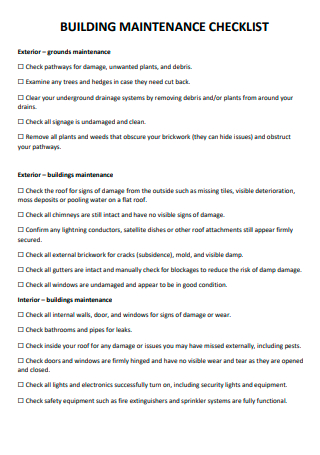
Building Maintenance Checklist Template
download now -
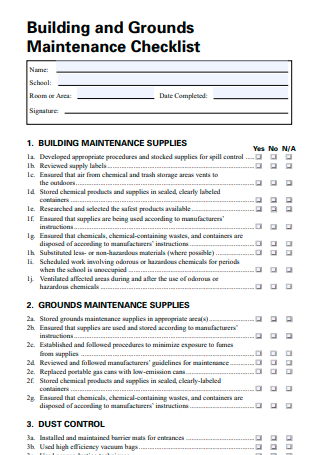
Building and Grounds Maintenance Checklist
download now -
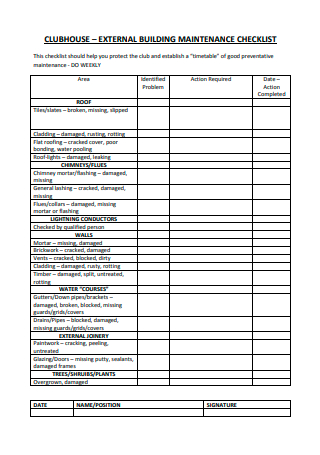
External Building Maintenance Checklist
download now -
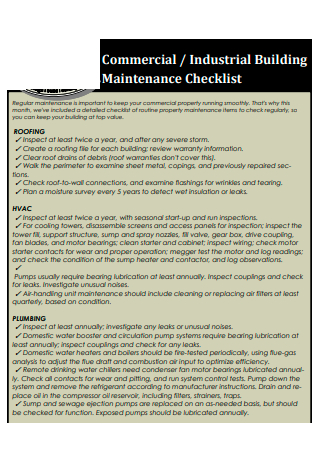
Industrial Building Maintenance Checklist
download now -
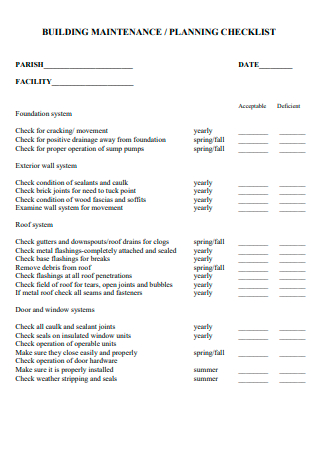
Building Maintenance Planning Checklist
download now -
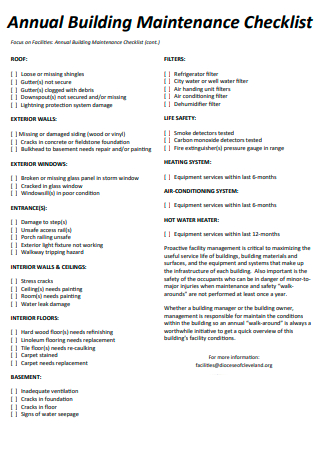
Annual Building Maintenance Checklist
download now -
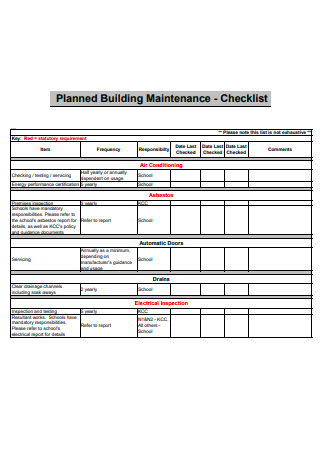
Planned Building Maintenance Checklist
download now -
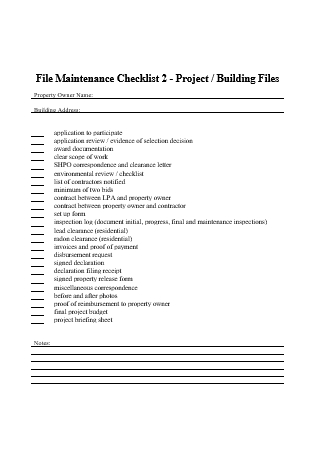
Building Maintenance Checklist in DOC
download now
FREE Building Maintenance Checklist s to Download
7+ Sample Building Maintenance Checklist
What is a Building Maintenance Checklist?
Who are the Building Maintenance Workers?
Categories of Building Maintenance
What are the Types of Activities Performed During Building Maintenance?
What are the Challenges Regarding Building Maintenance?
How to Prepare a Building Maintenance Checklist
FAQs
What are the various Building Maintenance Certifications?
What are the organizations that use building maintenance?
Is a building maintenance checklist a legally binding document?
What causes a building’s condition to deteriorate?
What is a Building Maintenance Checklist?
Before we go to the checklist part, we should talk about what is Building Maintenance first. Building Maintenance is defined as the necessary work that is done in order to keep and improve every facility or area to meet or exceed an acceptable standard and to sustain the value of the said building. Depending on the building, it includes a wide variety of tasks, such as cleaning common areas or repairing broken items. Building maintenance consists of a great deal of work in order to make sure it is functional for its users, as well as to make sure that it is comfortable for them. A Building Maintenance Checklist lists all the important areas and working of a particular building or facility that need to be inspected and maintained, to make sure that it is not neglected during the maintenance process.
Who are the Building Maintenance Workers?
These are some of the people you typically see that are performing the building maintenance procedure:
Categories of Building Maintenance
Building Maintenance can be divided into three categories. These are the following:
What are the Types of Activities Performed During Building Maintenance?
These are some of the types of activities performed during a building maintenance procedure:
What are the Challenges Regarding Building Maintenance?
Building inspection and maintenance isn’t as easy as putting one and one together to make two. It contains a number of challenges or problems that you usually face. Here are some examples of them:
How to Prepare a Building Maintenance Checklist
A Building Maintenance Checklist is a great tool to have in order to streamline the process of maintenance works. With that being said, here are the steps in preparing one:
1. Planning process.
Determine and detail the type of building maintenance that needs to be done, if it is preventive, corrective, or routine maintenance. Plan ahead on how many workers are needed, and how many tools are to be used in order to conduct the building maintenance. Include also the spare parts to be used in case replacing is necessary. Also plan for the number of working hours that the maintenance task needs, and the overall cost of the process. This is important to avoid using the wrong tools for the job, to control costs, and also to avoid having too many overworked workers for a single task.
2. List down the areas that need to be maintained.
After the planning process, this step follows. In this process, all the areas that require maintenance are to be listed down in the checklist. It can include the entire facility and its outside surroundings, or just the inside of the facility. Also, include in this process the type of maintenance that is to be done on each area of the building. It is also up to the person preparing this document if a questionnaire checklist can be done, or just a simple pass or fail checklist.
3. Leave spaces for feedback.
It is also important to leave some spaces in the checklist for feedback or maintenance report, problems found with the corresponding actions taken, and the recommendations from the workers who conducted the building maintenance. The recommendations written will help the facility manager to know if any more components that will need replacing or restoring in the next maintenance interval. The actions taken will also let the manager know what the maintenance workers did on the area they are inspecting and maintaining, and also if there are any defective parts found and immediately replaced.
4. Verify the checklist created.
When the creation of the checklist is done, make sure to verify it, to make sure that everything is correct from the type of maintenance to be done, the overall cost, the number of workers needed, their corresponding work hours, the type of tools, down to the number of spare parts needed for the building maintenance. Make sure that nothing of importance is overlooked, especially in areas that are already faded and show signs of decay. You should also check if there are areas of the building that don’t even need maintenance but you may have accidentally included. If you hand it over to the building maintenance workers, it is also important to let them know about the type of building maintenance to be done, and the components that you have included in the checklist, so they can also verify your created checklist and also to avoid any confusion.
FAQs
What are the various Building Maintenance Certifications?
Here are the 3 various certifications for building maintenance workers:
- HVAC Certification – This type of certification can be acquired if maintenance workers demonstrate enough competence in handling Heat, Ventilation, and Air Conditioning systems. Various apprenticeships help workers in handling these systems should they wish to acquire HVAC certification.
- Building Operator Certification – Areas covered in this type of certification include HVAC systems, energy management, control point management, and electrical distribution. There are also apprenticeships and approved institutions that offer this type of training to candidates, just like the HVAC Certification.
- Building Systems Maintenance Certification – This type of certification is offered to the workers who maintain building systems. The topics covered are efficient energy management, HVAC, plumbing, and water treatment.
What are the organizations that use building maintenance?
Here are the following organizations that make use of building maintenance:
- Businesses – Small businesses that have small budgets make use of their general operations and usually outsource the maintenance service by themselves. Larger businesses make use of their own in-house department for their own needs.
- Residential areas – These include apartment or condominium complexes. They usually hire and maintain a team of building maintenance workers to inspect, repair, maintain, and take care of any further maintenance needs of the entire complex.
- Government Organizations – Building maintenance teams are utilized by the government to make sure that the city buildings, government offices, post offices, etc. are always in good condition so they can properly serve the needs of the public.
Is a building maintenance checklist a legally binding document?
It totally depends. If it is just a simple checklist to be handed over to the building maintenance team, then it is not legally binding. However, if it becomes a maintenance contract, it is now a legal document. Maintenance contracts are usually made if the particular business is outsourcing its own maintenance service. A maintenance contract serves as a legal agreement between the company and its hired maintenance service provider.
What causes a building’s condition to deteriorate?
There are various reasons that can lead to a building’s deterioration. Here are some of them:
- Substandard materials – The use of lower than quality materials in buildings can lead to earlier deterioration of the infrastructure because it usually has the tendency to have less strength and worse manufacturing than materials that are of good quality.
- Improper Maintenance – This is the main cause of a building’s deterioration. Items that are usually skipped in the checklist in order to save time can have undetected signs of fatigue or failure. To combat this, a thorough maintenance procedure is to be observed.
- Harsh Environment – A building or infrastructure built in an environment that usually experiences harsh weather conditions will deteriorate faster, especially if the structure already has cracks present, which can serve as a pathway for harmful chemicals to enter the structure and speed up the deterioration process.
If a building maintenance team will perform their work, it is important for them to go through a proper checklist, and not just randomly going through items because they feel like it. Without a checklist, and without confirming that the area actually needs maintenance, the worker may do more harm than good and cause the number of problems to spike up. This article has examples of a building maintenance checklist listed above for use or reference.
